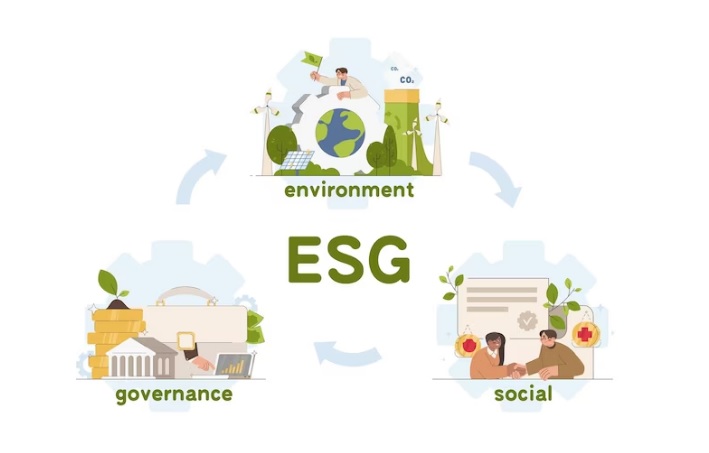Navigating ESG- A Path to Green Investing

Introduction:
In this blog post, ESG- A Path to Green Investing, I'll explore what green investment is all about, and the challenges of balancing risk and reward in this exciting and rapidly growing area of investing. ESG investing is rapidly gaining popularity worldwide, offering not just profit potential but also a chance to contribute to a better tomorrow.
ESG stands for Environmental, Social, and Governance. Investors are increasingly applying these non-financial factors as part of their analysis process to identify material risks and growth opportunities. ESG investing in India is evolving, with firms prioritising sustainability alongside profits. The BSE and NSE introduced ESG indices, guiding investors on companies' ESG performance. This shift signifies a move towards a more sustainable and responsible investment landscape. By integrating ESG factors, investors foster a sustainable and equitable future.

As the old saying goes, 'the early bird catches the worm’, which is certainly true when it comes to green investments. By investing in a sustainable company in its early phases, you can take advantage of the growth rally. But wait! Like any investment, risks are involved, and it's important to do your due diligence before investing your money.
What is Green Investment?
While navigating ESG A Path to Green Investing, it is important to understand that the green investment is all about investing in companies, projects, and technologies that have a positive impact on the environment. This can include investments in renewable energy, sustainable agriculture, clean water and waste management, and other initiatives that aim to reduce the negative impact of human activity on the planet.
The primary goal of green investing is to promote sustainable development and reduce carbon emissions. Green investments are designed to support companies working towards a more sustainable future, and they can offer several benefits to investors.
This can be achieved by supporting a green initiative by investing in Green FD and Green Bonds. You can also invest in companies that support Environmental, Social, and Governance (ESG) or companies whose business is targeted towards promoting sustainability, like renewable energy and projects that produce clean energy, reduce waste and pollution, and promote sustainable practices.

Now, investing in green FD and green bonds is fairly risk-free. In the case of green bonds, your invested capital is used towards a green initiative mentioned in the bond. Whereas, in the case of a green FD, your invested capital is offered as a loan for a green initiative.
The third option is investing in companies supporting green initiatives or companies whose business is solely manufacturing sustainable and environmental projects. However, before investing, you must analyse the company's business model, top line, bottom line, etc.
The Green Investment Dilemma?

While navigating ESG A Path to Green Investing, the green investment dilemma is the challenge of balancing the risks and rewards of investing in green technologies and renewable energy. On one hand, investing in green technologies and renewable energy can offer high returns and contribute to a sustainable future. On the other hand, investing in these technologies can also be risky due to the emerging nature of the industry and the uncertainties involved.
Benefits of Green Investment:
Investing in green technologies and sustainable projects can offer both financial and environmental benefits. Here are some of the benefits of green investment:-

1. Environmental Benefits:
Green investment can play a critical role in promoting sustainable development and reducing carbon emissions. Investing in technologies and projects that produce clean energy, reduce waste and pollution, and promote sustainable practices can contribute to a more sustainable future for our planet.
2. Financial Returns:
Green investment can offer the potential for high returns, especially as governments and companies worldwide continue to invest in renewable energy and other green initiatives. By investing in green technologies and sustainable projects, investors can potentially earn financial returns while promoting sustainability.
3. Positive Impact on Society:
Green investment can create new job opportunities and stimulate economic growth. For example, investing in renewable energy projects can create jobs in the manufacturing, construction, and maintenance sectors, contributing to the growth of local economies.
4. Competitive Edge:
Companies that invest in green technologies and sustainable practices may have a competitive edge over companies that do not. Consumers are becoming more conscious of the environmental impact of the products and services they purchase and may prefer to do business with companies that are environmentally responsible.
5. Diversification:
Green investment can help diversify an investment portfolio, spreading risk across a range of green technologies and renewable energy projects. This diversification can potentially reduce the overall risk of an investment portfolio.
6. Positive Impact on Public Health:
Investing in clean energy and sustainable practices can lead to improved air and water quality, reducing the negative impact of pollution on public health.
While navigating ESG A Path to Green Investing, these are just some of the benefits of green investment, and there are also tax benefits associated with green investment, depending on the country and its tax laws. Here are some examples:-
1. Tax Credits and Deductions:
Many countries offer tax credits or deductions for investments in renewable energy projects, such as solar or wind power. These tax incentives can reduce the amount of tax owed on income, providing a financial benefit to investors.
2. Tax-exempt Bonds:
In the United States, investors can purchase tax-exempt bonds to finance environmentally friendly projects, such as energy-efficient buildings, water treatment facilities, and public transportation systems. These bonds offer tax-free income to investors.
3. Capital gains Tax Exemptions:
In some countries, such as the United Kingdom, capital gains tax exemptions may apply to investments in certain green projects. For example, if an investor sells shares in a company that invests in renewable energy, any capital gains from the sale may be exempt from capital gains tax.
4. Reduced Property Tax:
In some jurisdictions, properties that have been certified as environmentally friendly may qualify for a reduction in property taxes.
5. Reduced Corporate Tax:
Some countries offer reduced corporate tax rates for companies that invest in environmentally friendly technologies or practices. This can incentivize companies to invest in green initiatives.
It is important to note that tax benefits can vary depending on the country and its tax laws, so investors should consult with a tax professional to understand the specific tax implications of green investment in their location.
Risks of Green Investment:
While navigating ESG A Path to Green Investing, but while the benefits of green investment are clear, there are also risks to consider. Here are some examples of risks that investors may face when investing in green initiatives:

1. Political Risk:
The regulatory environment surrounding green investments can change rapidly, which can create political risks. Governments may change their policies and regulations, which can impact the financial returns of green investments. For example, a government could remove subsidies for renewable energy projects, or introduce taxes or fees on carbon emissions, affecting the profitability of green investments.
2. Technological Risk:
Green technologies are often new and untested, which can create technological risks. There is a risk that the technology may not work as intended, or that a better technology may be developed, rendering the investment obsolete.
3. Market Risk:
Green investments are subject to market fluctuations and may be influenced by supply and demand factors. There is a risk that green technologies may not be as profitable as expected, or that the market may not be receptive to them, leading to lower financial returns.
4. Economic Risk:
Green investments may be influenced by economic factors, such as interest rates, inflation, and economic downturns. A recession or economic slowdown could negatively impact the profitability of green investments.
5. Operational Risk:
Green investments may face operational risks, such as project delays, cost overruns, or technical difficulties. For example, a wind turbine project may be delayed due to issues with obtaining permits or land access.
6. Reputation Risk:
Companies investing in green initiatives may face reputation risks if the investment does not align with their values or if the investment results in negative social or environmental impacts. This can negatively impact the company's brand and reputation.
7. Analysing Stocks is Difficult
A few green companies may be in the early stages of development, and hence they may not have a strong track record of financial performance. Hence, predicting how they will perform in the future can be challenging. This means that investors must do their due diligence and carefully evaluate the risks of green investments before investing.
Balancing Risk and Reward
While navigating ESG A Path to Green Investing, balancing the risks and rewards of green investments requires a thoughtful approach. To manage risk, investors should conduct thorough research into potential investments and consider diversifying their portfolio across a range of green technologies and renewable energy projects.
Investors should also consider the impact of government policies and regulations on their investments. Understanding how policy changes can impact the value of investments can help investors to make informed decisions and manage risk.

But don’t lose heart, as you can still consider diversifying your portfolio by including a few green stocks in your traditional portfolio and reap the benefits of the green investing trend.
Conclusion:
As the old saying goes, 'You can't have your cake and eat it too,’ meaning you cannot do two things simultaneously. However, when it comes to green investments, it is possible to invest your money while also supporting sustainability.
As the importance of sustainability continues to grow, green investment is likely to become an even more important part of the investment landscape. So, if you're interested in green investment, now is the time to start exploring your options and considering how you can balance the risks and rewards of this exciting and rapidly growing area of investing and become an even more important part of the investment landscape.
Thank you for reading "ESG A Path to Green Investing", and stay tuned for more updates on the world of green investment!

